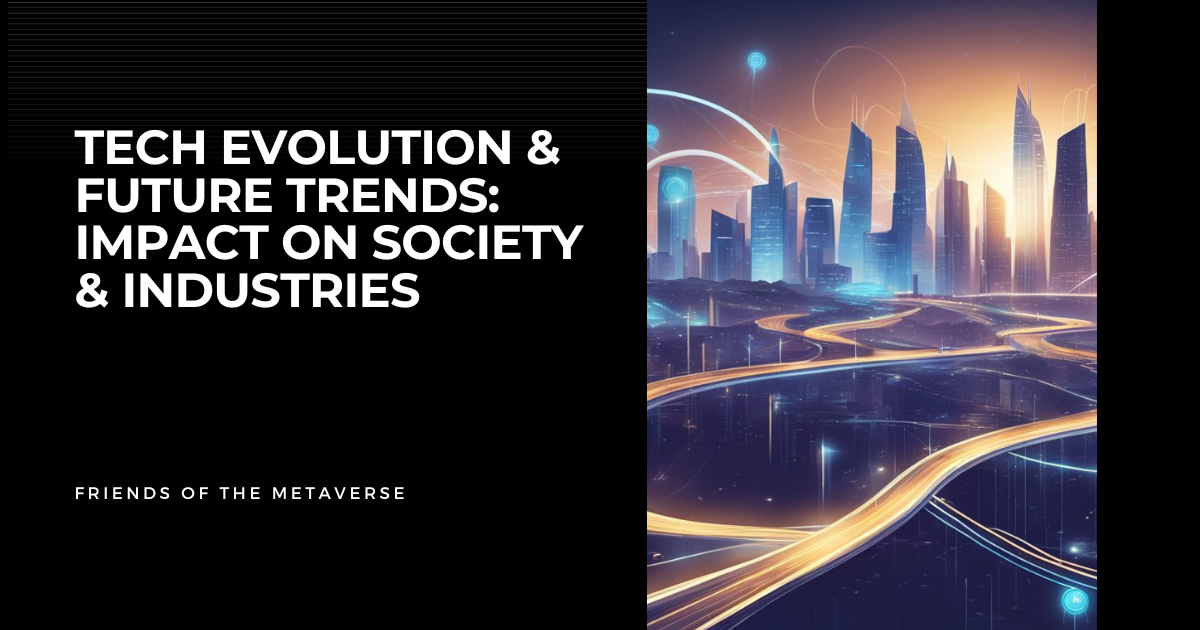IMPORTANT: This blog was created with the assistance of artificial intelligence and has undergone further review and editing by our editorial team to ensure accuracy and compliance with relevant standards.

5G Unleashed: Accelerating the Future with Next-Gen Wireless Technology
5G technology represents the next major phase of mobile telecommunications standards beyond the current 4G LTE networks. As the fifth generation of wireless networking technology, 5G is designed to deliver faster data speeds, lower latency, and more reliable connectivity. This innovation is not just about providing enhanced speeds to smartphones; it's also poised to enable new applications in fields such as the Internet of Things (IoT), autonomous vehicles, and smart cities, transforming how these technologies communicate with one another.

Quantum Computing Revolution: Powering Future Innovations Across Industries
Quantum computing represents a significant leap forward from traditional computing, harnessing the strange and counterintuitive principles of quantum mechanics to process information in entirely new ways. It harnesses quantum bits, or qubits, which can exist in multiple states simultaneously, a concept vastly different from the binary bits of classical computing. This emerging technology has the potential to solve problems that are currently intractable for classical computers, offering speed and efficiency improvements that could revolutionize various fields, including cryptography, materials science, and pharmaceuticals.

Revolutionizing Tech: How Blockchain Fuels Innovation & Security
Blockchain technology stands at the forefront of modern digital innovation, offering a robust architecture that enhances the reliability and security of online transactions. It operates as a decentralized public ledger that records digital transactions across multiple computers, in such a way that the record cannot be altered retroactively without altering all subsequent blocks. This immutability is what makes blockchain a game-changer in various sectors, particularly in banking, supply chain management, and secure data transfer.

Apple Vision Pro: The Dawn of Spatial Computing Era
Spatial computing marks a paradigm shift in technology, representing the next step in the integration of digital and physical environments. By enabling computers to interpret and interact with the three-dimensional space around us, this innovation promises to redefine how we work, play, and communicate. Apple's foray into this domain with the introduction of the Apple Vision Pro signals the tech giant's commitment to solidifying its place at the forefront of this technological revolution. Designed to seamlessly blend digital content with the physical world, Apple Vision Pro extends the user interface into a fully dimensional experience, transcending the limitations of traditional displays.

Unlocking Innovation: Strategies for Creative Mastery
Innovative thinking is the lifeblood of successful business and personal growth, which hinges on a person's ability to look beyond the conventional and bring forth new ideas. Creativity isn't just an innate talent; it is a skill that can be honed with consistent effort and the right strategies. The pace of change in today's world demands agility in thought processes, and individuals possessing the capability to innovate typically stand out in their respective fields, contributing unique solutions and alternatives to routine challenges.

AI & Metaverse Synergy: Pioneering Digital Innovation
The intersection of artificial intelligence (AI) and the metaverse is forging a new frontier in digital innovation. AI is the driving force behind creating realistic and responsive environments within the metaverse, offering personalized experiences that are profoundly engaging. Through the integration of AI, these expansive virtual spaces become more than mere repositories of static content; they evolve into platforms where user actions shape the narrative and the digital landscape itself.

Master Continuous Learning in Tech: Strategies for Staying Ahead
In the ever-evolving landscape of technology, staying updated is not just beneficial, but essential for professionals and enthusiasts alike. Rapid advancements in tech mean that skills can become obsolete almost as quickly as they emerge. Whether it’s the latest software update, a breakthrough in hardware capabilities, or a revolutionary new service, keeping abreast of these changes ensures that individuals and businesses can maintain a competitive edge.

Tech Evolution & Future Trends: Impact on Society & Industries
Explore the transformative journey of technology, from AI and quantum computing to sustainable innovations and cybersecurity. Understand the significant impact on various industries, society, and the environment as we navigate future tech trends.

Navigating the Future with Ethical AI: Principles, Impact, and Implementation
Artificial Intelligence (AI) stands at the forefront of technological advancement, reshaping industries and day-to-day life with its remarkable capabilities. As these intelligent systems become increasingly integrated into the fabric of society, establishing a foundation of ethical AI is paramount. The responsible deployment of AI hinges on ensuring that these technologies are developed and utilized in ways that respect human rights and promote fairness. It is an imperative step to guard against the potential negative implications of AI misuse, such as the amplification of biases or the erosion of privacy.

Revolutionizing Finance: How AI Redefines Money Management & Services
Artificial intelligence has become a pivotal force in reshaping the landscape of financial services. The application of AI technologies is transcending traditional banking boundaries, enhancing operational efficiencies, and offering a personalized experience to customers. Financial institutions are leveraging AI to automate routine tasks, mitigate risks, and even to foster innovation in product and service offerings. This evolution is not merely a trend but a wholesale revolution, redefining how financial services operate, engage with their clients, and manage their internal processes.

Exploring Advanced AI: Transforming Industries & Future Innovations
Artificial Intelligence (AI) has significantly transformed the technological landscape, introducing capabilities that extend far beyond human abilities in specific tasks. Today, advanced AI technologies are shaping various sectors, from healthcare to finance, offering solutions that promise to enhance productivity, automate mundane tasks, and even solve complex problems that have puzzled experts for years. At the forefront of these innovations are tools and systems that employ deep learning, natural language processing, and robotics, illustrating the breadth of AI's potential impact on society.

AI & Climate Change: Revolutionizing Green Solutions for a Sustainable Future
Artificial intelligence (AI) is playing an increasingly significant role in addressing the monumental challenge of climate change. By leveraging its ability to analyze large datasets and identify patterns, AI is shaping strategies for mitigating harmful emissions and developing sustainable solutions. Specifically, AI contributes to designing energy-efficient buildings, optimizing the deployment of renewable energy sources, and enhancing waste management strategies. Its role extends across various sectors, underscoring the potential of technology-driven approaches in reducing the global carbon footprint.

Revolutionizing Healthcare: The Transformative Power of AI
Artificial intelligence is making strides in transforming the landscape of healthcare, offering innovative solutions to longstanding challenges. AI's ability to analyze complex datasets rapidly has led to improved diagnostic accuracy, more personalized treatment plans, and enhanced disease prediction models. These advancements are not only streamlining operational efficiencies but also elevating patient care to new heights. Through machine learning algorithms and advanced data analytics, AI is enabling healthcare providers to unravel complicated medical mysteries faster than ever before.

Mastering AI: Machine Learning vs. Deep Learning Explained for Beginners
Machine learning and deep learning are both integral components of artificial intelligence, each with unique capabilities and applications. Machine learning is a broad field of AI that enables computers to learn from and make decisions based on data. It encompasses a variety of techniques that allow machines to improve at tasks with experience, using statistical methods to infer patterns and make predictions.

Spatial Computing: Bridging Digital and Physical Worlds for Future Innovation
Spatial computing represents a convergence of various technologies that collectively have the potential to transform our interaction with the physical world. It integrates the spatial dimension into computing, allowing both hardware and software to recognize and interpret physical space within the context of digital data. The foundations of spatial computing lie in enabling devices to locate themselves within an environment and interact with it realistically, be that through augmented reality, virtual reality, or other location-based technologies. This has the transformative potential to advance sectors as diverse as gaming, engineering, and urban planning, making the opportunities that spatial computing presents both vast and multidimensional.

Spatial Computing: Transforming Business with AI and Immersive Tech
Spatial computing is a technology that offers transformative opportunities for businesses by integrating the physical world with digital information using a variety of tools such as artificial intelligence (AI), augmented reality, and virtual reality. The essence of spatial computing lies in its ability to create interactive and immersive experiences that transcend traditional two-dimensional interfaces. It enables objects to be manipulated in three dimensions, thus offering novel ways to visualize data, collaborate remotely, and interact with digital content within a real-world context.

Spatial Computing: Bridging Digital and Physical Realms in Daily Life
Spatial computing represents a significant leap in technology, merging the digital and physical worlds in a way that enhances everyday life. This emerging field involves the integration of AI and advanced sensors to understand the environment and create interactive 3D simulations. With spatial computing, digital information is no longer confined to screens but is instead overlaid on the physical world, which allows for more natural interactions with technology. These interactions are powered by AI, which interprets gestures, voice commands, and context to facilitate seamless user experiences.

AR & VR Evolution: Spearheading Spatial Computing's Immersive Breakthrough
Spatial computing represents the next wave in computing technology, blending the physical and digital worlds in ways that change how humans interact with machines and data. It encompasses technologies such as augmented reality (AR) and virtual reality (VR), which are integral components of this evolution. AR enhances the real world by overlaying digital information onto the physical environment, making details such as navigation cues or product features accessible in context. Conversely, VR immerses the user in a completely digital environment, offering a rich, simulated experience that can transport individuals to new or recreated places for training, entertainment, or education.

Unlocking the Potential of Spatial Computing in Industry Innovation
Spatial computing is rapidly transforming how industries operate, innovate, and deliver services. It brings together the physical and digital worlds in ways that were previously unimaginable, allowing for the creation of environments where humans can interact with digital content in a realistic manner.

Revolutionizing Reality: Spatial Computing's Impact on Future Industries
Spatial computing represents the integration of the physical world with digital information, where computers recognize and interact with the environment around them. Unlike conventional computing paradigms, spatial computing allows for the interaction between users and digital content to unfold within a three-dimensional space. This technology transcends the limitations of screens and devices, bringing forth an era where information and communication seamlessly coalesce with real-world contexts.
